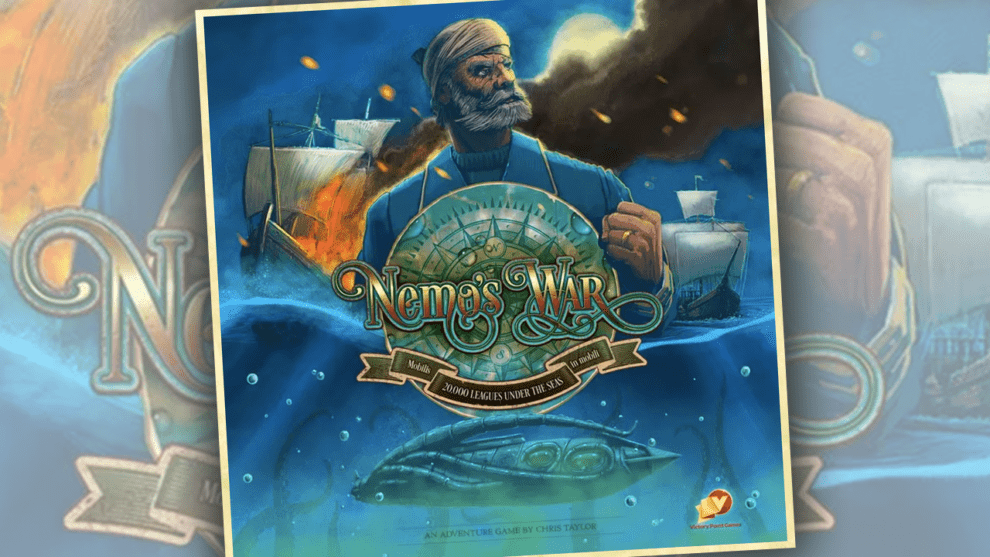Disclosure: Meeple Mountain received a free copy of this product in exchange for an honest, unbiased review. This review is not intended to be an endorsement.
Far from the confusion of the typical “chicken or the egg” argument, I know exactly which came first: I sought out the board game before the novel. Then again, I did seek out the board game because I wanted to read the novel. And I did finish the novel before I started the board game. But it was all because of the—
Nevermind. The point is that I wanted to go all in on the solo tabletop adventure at hand. Until recently, I had never read Jules Verne’s 20,000 Leagues Under the Seas. I was familiar with the 1954 Disney classic featuring James Mason as Nemo. At the age of eight I remember enjoying the ride at Disney World. But I can’t say I had ever put myself in the Captain’s shoes. I was probably confused. Both Disney efforts keep Sea as singular in their titles, which makes it sound as if a submarine descended nearly 70,000 miles into the earth—which has a diameter of around 8,000 miles. So I picked up the book to get the story straight and prepare for the game.
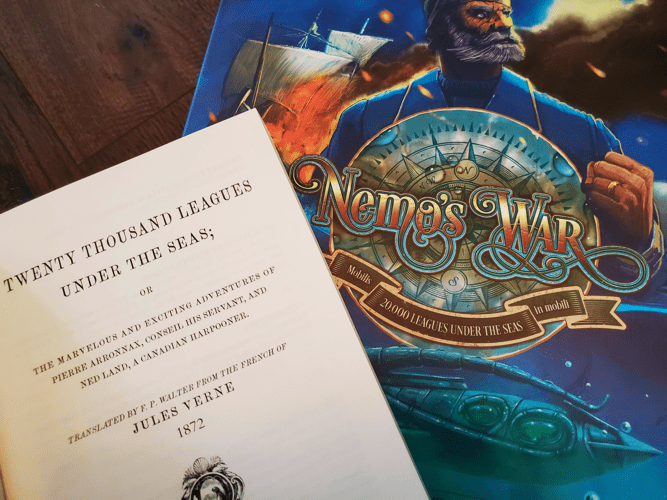
Nemo’s War wins its first battle by getting the name right on the box cover. It wins bonus points for including as well the motto of the Nautilus, Mobilis in mobili. Moving within motion. Change within change.
First published by Victory Point Games in 2009, Nemo’s War portrays the enigmatic Captain Nemo in his Nautilus for an underwater adventure. The Christopher Taylor design draws heavily on the original novel to present an obviously solo game. Yes, there are modifications in place for semi-cooperative or cooperative play for up to four players, but at heart—like the captain himself—Nemo’s War is one individual’s struggle against the world.
The Summary
Nemo’s War takes place on a sprawling six-fold board that doubles as a sprawling player aid. The central map highlights six major seas and several minor seas around the world, the staging ground for the various battles and explorations. Throughout the game ships will arrive, a fact which seems far from hostile. But more ships in the water mean a greater chance one might aggravate the intentions of the Captain. In short, it’s preferred that wandering vessels rest at the bottom of the sea. After all, free of such interference, Nemo and his underwater crew would be free to explore the depths and silently influence matters on land.
The turn sequence is: 1) Reveal an Adventure card to progress the story, 2) Roll to update the board state and determine the available action points, 3) Run through Actions.
The Events
Each turn begins by drawing an Event from the prepared Adventure deck of 30 cards. 20,000 Leagues is uniquely qualified for an adaptation like this because of the novel’s episodic nature. The original tales—and thus the cards—hold together, but they need not necessarily occur in a specific order. Each Adventure card is either a Keep (an effect that will occur later), a Play (an immediate effect), or a Test. The deck also contains certain predetermined cards to push the intensity of the narrative and the corresponding mechanics until the Finale.
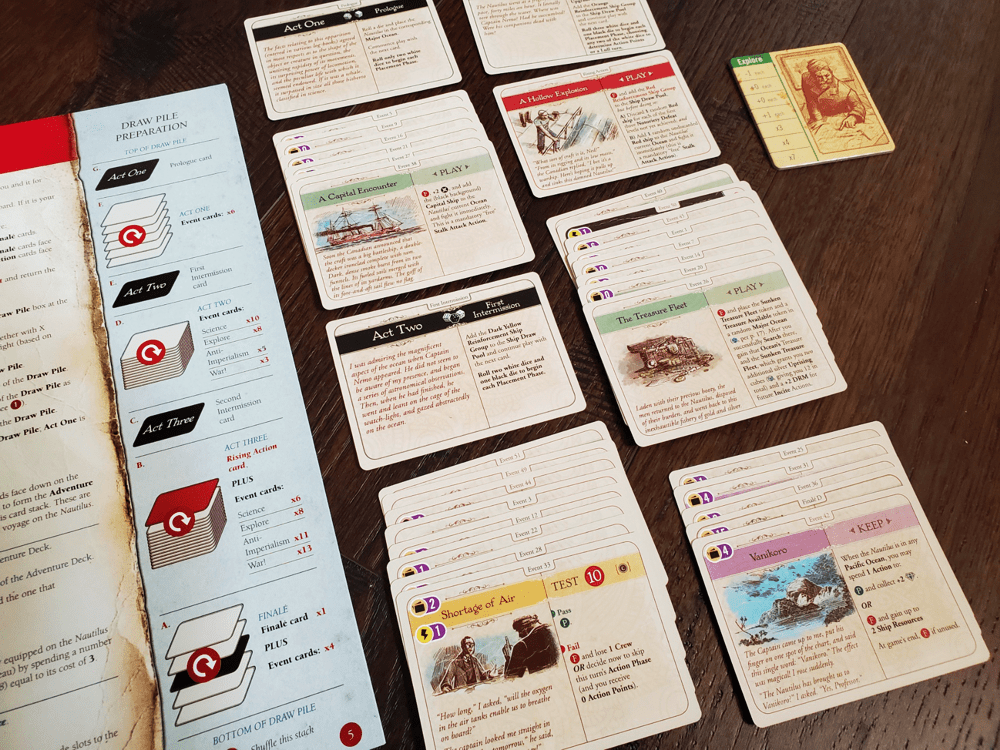
Many of the Adventure cards in Nemo’s War—and the actions in general—consist of Tests. Roll two dice to match or beat a specific value. Pass the test, gain the reward. Fail the test, suffer the consequence. It’s not always so neat as that, but the mechanism doesn’t change.
Every dice roll in Nemo’s War can be modified. Certain upgrades to the Nautilus provide modifiers in specific conditions. Various human individuals on the vessel can be sacrificed for benefits in a pinch, though these are rather costly in the long run. Likewise, treasures can be discarded in advance to bolster rolls.
Most commonly, modifiers come by wagering points along one of three tracks on the board that measure the health of the moment: The Hull, the Crew, and Nemo himself. Before a given roll, the marker on one or more tracks might be moved to indicate a wager that will modify the dice. In the event of success, the marker returns to its place. In failure, though, the wager is lost and additional penalties may then ensue. Should any of these tracks reach their limit, the game is immediately lost.
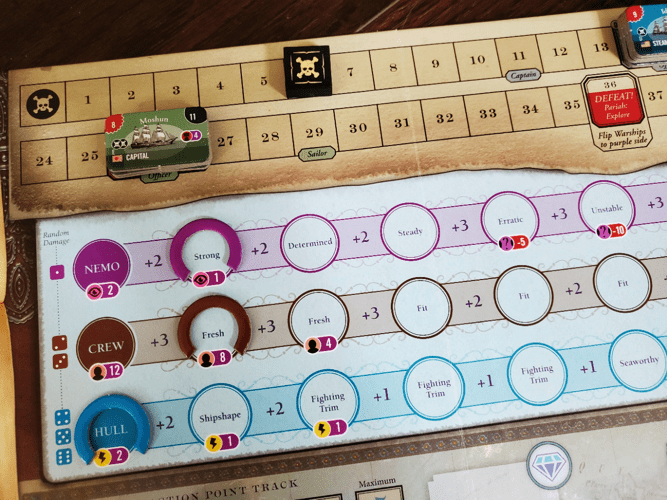
The Placement
After the Adventure card is revealed and handled, a number of dice determine two key bits of information. First, ship tokens are added to the board in the sea indicated by each die. As the game progresses, more dice are involved and the situation grows increasingly volatile. There is a progression by which the ships are added: first as hidden vessels, then as revealed, first in the specific sea, then to overflowing seas. If ever a ship placement runs through the entire progression without finding a home, the game is immediately lost.

There are white and black dice in the game. All of the dice contribute to ship placement. Only two white dice are then used to determine the number of Action Points awarded, which are calculated by taking the difference between. A two and a six, for example, grant four Action Points.
Doubles trigger what is called a Lull turn. Lull turns are akin to passing, though there are opportunities for action if any points were reserved in a previous round or if there are any tokens to spend, perhaps by sacrificing one of the humanfolk mentioned earlier. Lull turns also replenish available treasures around the board. The offset, however, is that Nemo’s inaction allows world governments to catch up on his subversive activities by removing cubes added through the Incite action (see below).
The Actions
Action Points feed seven (let’s call it seven-and-a-half) actions: Searching for treasure, Resting the crew, Repairing the Hull of the Nautilus, Refitting the Nautilus with upgrades, Inciting political unrest on the map, random Adventuring through the excess cards that weren’t shuffled into the deck, and Attacking ships on the water.
Each of the actions is spelled out on a series of tables on the board. The small Action Cost Table provides a menu for how to spend Action Points. The Action Table indicates the outcome of every dice roll based on the chosen action. The bulk of time is spent deciding how to spend a very limited number of points, and how to modify and maximize the results of the dice.
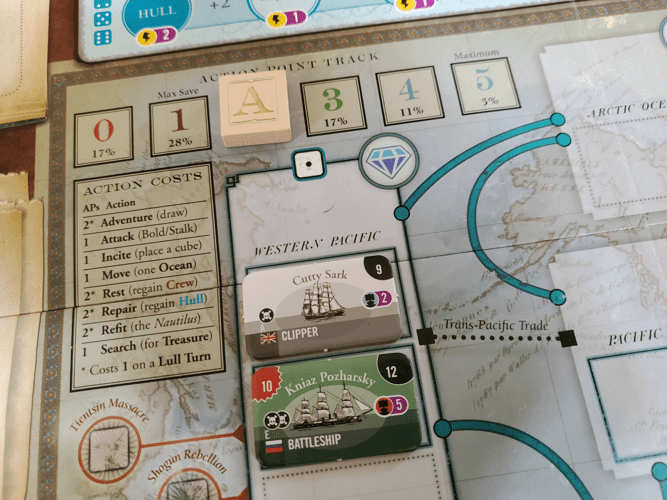
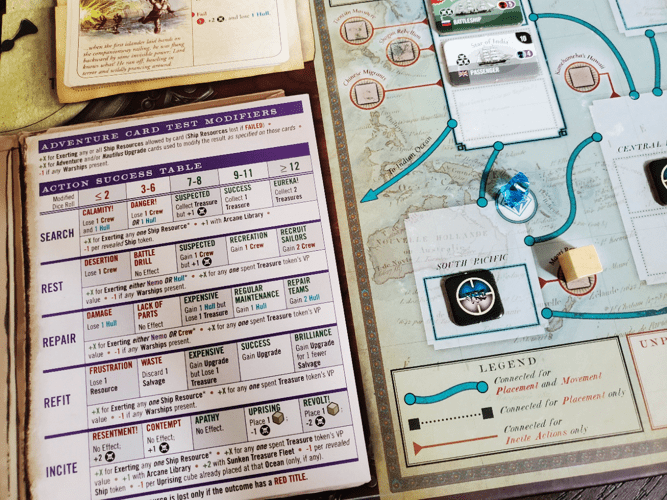
Across the top of the board is a track marked by a Jolly Roger token. It is important to keep the Notoriety of the Nautilus under control throughout the game, as an excess will result in an immediate loss. At the outset of the game, the player chooses a Motivation for Nemo in the game: Science, Exploration, Anti-Imperialism, and War. Each Motivation comes with a unique trigger point on the Notoriety track that will end the game. Various actions in the game add Notoriety (most notably Attacking), while Inciting keeps the track in check.
Attacking is an animal all its own and worthy of the and-a-half comment above. There are two methods of attack. Stealthy attacks are one-off maneuvers that (hopefully) sink a ship before descending to the depths again. This more restrained attack comes with a bonus to the dice. Bold attacks, on the other hand, are aggressive chain attacks aimed at cleansing a sea of multiple ships. While both attack methods cost but a single Action Point, the Bold Attacks bump the Notoriety track as payment for a continued tirade.
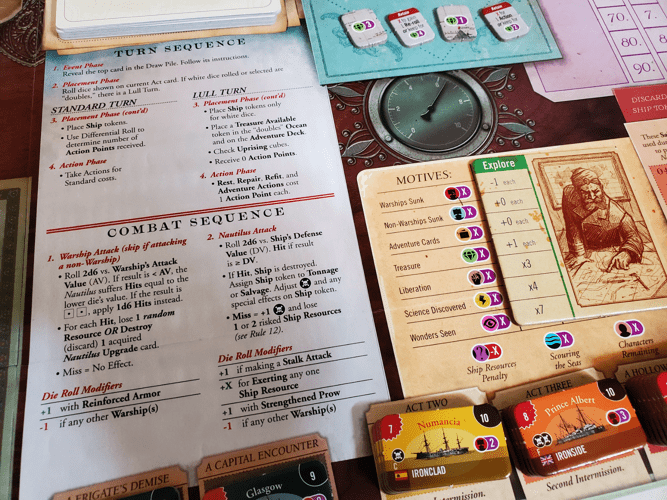
Attacks on non-Warships occur without worry of returned fire. Warship attacks begin with the Nautilus on the defensive. The system within Nemo’s War is such that high dice rolls are always good for the Nautilus and snake eyes are always devastating. It really helps with developing an intuition for the game. After withstanding enemy fire and assigning any damage, Nemo directs his fury on the vessel. Dice modifications help set the stage, and with a bit of luck the ship heads for Davey Jones’s locker.
At this point, there is a choice. By assigning the ship to the Tonnage chart, Nemo acquires a global trophy case of sorts filled with wreckage at the bottom of the seas. At the end of the game there are valuable points to be had based on a deep and wide reign of aggression spanning the planet. Assigning a ship to Salvage, by contrast, means the crew of the sub pilfers the rich stuff to apply to upgrades for the Nautilus (the Refitting Action).
There are countless other details to rolling the dice, but about 85% of it becomes second nature in a hurry. Still, pages 18-25 in the rulebook are high traffic areas at the beginning when it comes to Attacks. The rest of the Actions are straightforward.
Getting Out Alive
If at any point: Nemo, the Crew, or the Hull reach zero; the Notoriety track reaches its marked end; or a ship Placement runs the progression without finding a home, the game ends in immediate defeat. If, however, the Nautilus endures the pressures and the Finale card is revealed from the Adventure deck, one final Test stands in the way of survival.
Having survived, the player earns the right to calculate the score to determine the game’s Epilogue. One of the extra expenses of the box, but one that is delightfully thematic, is a book of Epilogues. Depending on Nemo’s motive and the scored result, the story comes with a conclusion. What becomes of Nemo and his efforts? You’ve got to survive to find out.
Scoring ranges all over. Nemo’s Motivation placard indicates scoring modifiers for every piece in the game: Science and Exploration place value on Wonders and Scientific Discoveries, War values sunken wreckage, etc. Players then add up every sunken ship (often in the dozens), treasure token, Passed Adventure card, non-sacrificed human (it sounds so strange to say it like that), plus bonuses from the Tonnage chart, the three Tracks, and probably others that I’ve forgotten. Calculators are welcome.
Other Way(s)
There are ways to adjust the difficulty and rhythms within the game, primarily through the wagers and penalties assigned through the ordinary mechanisms. There is also a set of tokens named Deadly Seas that are available to add to the ship pool as random events that raise the difficulty overall.
A variant called Relentless Pursuit adds a layer to the Action phase that could cause every ship in the Nautilus’s current sea to attack. This bit of chaotic goodness makes the game infinitely more difficult if the dice are not rolling your way. Likewise the Imperialist Naval Coordination variant disadvantages the dice to make the game more challenging. The variety in the box could be likened to some sort of medieval torture device if you’ve not found the game’s difficulty to be respectable.
The Fully Cooperative mode is not much different than the solo affair. Players gain and lose the Captaincy, from which they make the bulk of the critical decisions, while the other players hold a set of responsibilities that they maintain throughout the game. I’ve not tried these variants, but they seem to be organized ways of involving multiple people and giving others a shot to play some of the turns.
The Semi-Competitive mode allows players to keep their Passes and Fails as individuals along with treasure gem markers. These markers can be spent to seize the Captaincy. Players work together to keep the Nautilus in working order and her Captain functional, but should they survive, the gloves come off on the scoreboard.
Pondering the depths
20,000 Leagues Under the Seas is a fascinating novel about the nature of freedom and the wonder of living. Professor Arronax is the protagonist, however, and Nemo remains something of a mystery. The Captain disappears for chapters at a time in the narrative, leaving Arronax and the audience to scratch their heads. Nemo’s War flips the script entirely, putting the complicated seaman in the spotlight and relegating the supporting cast to the shadows. That’s why the game works. And wow, does it work.
Nemo’s War is tough, but It’s not impossible. I’ve survived and even logged a solid score thus far. But the dice were hot and I can genuinely say I got lucky. I’m still a babe in terms of evaluating strategy and possibility.
My greatest appreciation for Nemo’s War is in the fidelity to Jules Verne’s original. There are fifty or so Adventure Cards in the game, each with a unique illustration and flavor text from the novel. The player puts on Nemo’s shoes, and every mechanism serves to lace them tightly. His divided interest in science & technology, war and justice, all shine through in the decision spaces as does his occasional apparent disregard for himself and others. There are times to attack boldly, times to hit and run, times to throw on the dive suit and leave the ship, times to lean into loyal friends and subjects, and times to betray everything in the name of passion. I love it all.
As I’ve said already, the game board is supremely helpful. It is overwhelming at first for all the charts and tokens scattered about, but in the long run it speaks with more clarity than the rulebook. I admit, it’s difficult to decide how to organize the dearth of information involved in this game, but it doesn’t help when 10% or more of the terms on every page are bold. The point of bolded words is to highlight their unique importance. Just because a word is bold the first time doesn’t mean it needs to be every time thereafter. The organization is, for my taste, a bit out of order, but I managed to learn the system to a point of comfort after a few plays.
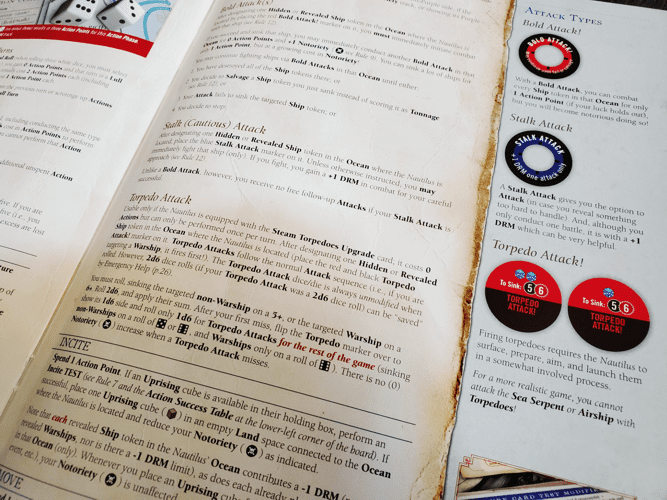
The only piece of the game board that I found extremely counterintuitive is the scoring track. It’s designed to mark 10’s and 1’s in the various departments—that part I understand. But the token markings are confusing to my feeble brain. To be honest, I’ve skipped the track entirely in every play in favor of making a list. Call me old fashioned or dull, I suppose.
The production is worth spending time with. The tokens and chits are thick enough. The Nautilus mini, though not quite what I envision from the novel, is slick. The cards have a nice quality. The treasures are not great, but there are so many, and they’re two-sided, so I can’t complain. The dice are fairly standard, but also sturdy, which is good because there is a lot of rolling in here.
I have mixed feelings on the dice. It’s possible to have a real stinker of an experience if the dice don’t cooperate. By the time the additional white dice enter play, allowing for the selection of two dice and a bit more flexibility, it might be too late. Then again, when the dice are rolling, no ship will stand against the mighty sub. This is in the nature of the game.
One mitigation rule that I appreciate but have a hard time using comes at the turn to the Third Act. If the Notoriety track is out of control and the wrong ships have been surfacing the whole game, or if the seas have not been friendly for treasures, there is a breakpoint at which the player can swap out Nemo’s Motivation for a more suitable choice. I say I struggle to use it because I want to see my opening decision through to the end, but I appreciate the option to adapt to the situation. Scoring the same board state with one Motivation over another could result in a difference of 50+ points, so it definitely matters.

I love the strange affinity for the Lull turn. Lull turns cripple action potential by denying additional Action Points. But they also progress the story, sometimes in rapid fashion. A brief run of Lull turns might turn up a few Keeps and Plays, and life feels like a dream. But those turns also add ships to the map in bulk, so a peaceful board state can quickly turn hostile while you hold the fast forward button. If the board state is well managed, it’s possible to seek out Lulls to propel toward the Finale.
The Tonnage Chart is a genius touch to force movement around the map. In order to score well, the Nautilus must navigate all the seas, sinking ships as trophies, and adding them to the display in order to maximize the score. Occasionally it hurts to put a ship in Salvage to buy an upgrade, but this is the nature of the game’s aggression.
I’ve not bothered with the multi-player efforts. I don’t see how they would enhance play. It would be just as easy to sit down with a friend to play, sharing decisions, dice rolls, reading, and pondering. The idea of jockeying to control the Captaincy isn’t as appealing to my imagination, but just as I understand the perceived need to include solo modes in every game that ideally plays with four, the reverse is true and there likely needed to be some ideas for those who want to explore the seas of a solo game together.
Overall, Nemo’s War is a winner in so many ways. I highly recommend the novel as a companion and preparation for the game as I believe it will enhance the experience (Just brace yourself for lists of fish and latitudinal & longitudinal coordinates along the way). Heck, check out the movie too while you’re at it. Nemo’s War then becomes another overlapping circle in the broader exploration of Jules Verne’s man of mystery and this imaginative look of what it might be like to almost-but-not-really check out on humanity and circle the globe in the solitude of the ocean depths.


